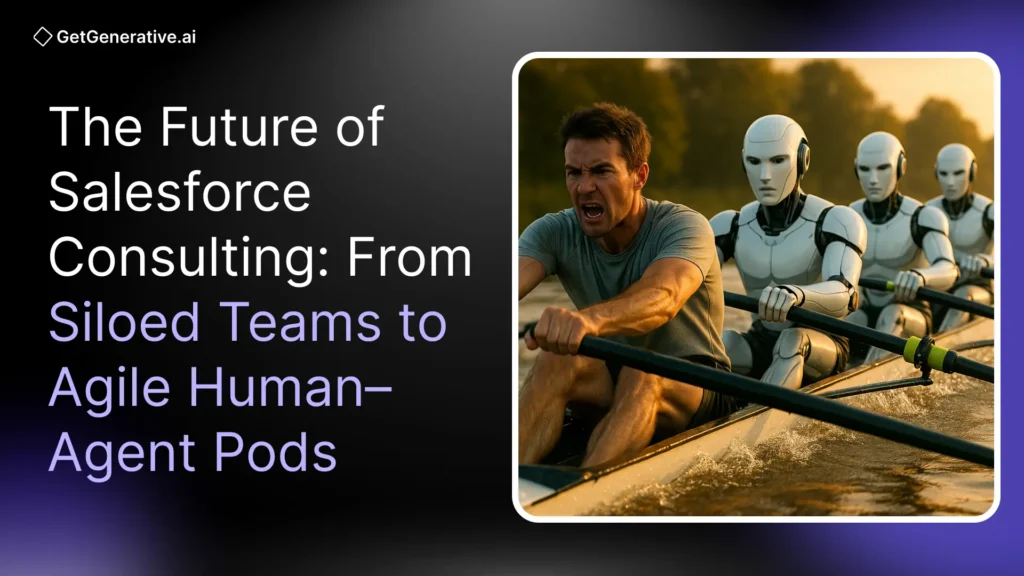The Future of Salesforce Consulting: From Siloed Teams to Agile Human–Agent Pods
For decades, Salesforce consulting has relied on a well-defined delivery model — rigid roles, hierarchical teams, and linear execution. In a typical implementation, you’d find a Project Manager managing timelines, a Business Analyst gathering requirements, a Technical Lead shaping architecture, Developers writing Apex, Admins configuring the platform, and Testers ensuring quality.
This model thrived in an era when complexity was best handled through specialization, and “fast” delivery still meant months — sometimes years. But that era is ending. The rise of AI-native consulting and specialised Salesforce AI Agents is dismantling the assembly-line approach.
The future belongs to agile human–agent pods — compact, high-performance teams where a few versatile humans collaborate seamlessly with AI Agents to deliver Salesforce projects faster, more cost-effectively, and with higher quality than ever before.
Why the Traditional Model Is Breaking Down
The old Salesforce delivery structure was built on industrial-age thinking — inspired by manufacturing lines where each person owned a fixed part of the process. The logic was simple:
- Assign specialists to specific tasks
- Keep roles separate to maintain deep expertise
- Coordinate through multiple management layers
In practice, this created chronic inefficiencies:
- Excessive handoffs — requirements bounced from BA to Tech Lead to Developer to Tester, with delays and misinterpretations at each stage.
- Role silos — limited cross-visibility and little empathy between disciplines.
- High fixed costs — larger headcounts to keep all roles staffed.
- Slow adaptability — workload imbalances created bottlenecks that couldn’t be quickly resolved.
AI breaks this model because it eliminates many of the repetitive, document-heavy tasks traditionally spread across roles. With AI Agents doing the mechanical work, consultancies no longer need an army of narrowly focused specialists.
The Human–Agent Pod: The New Standard
In the emerging human–agent pod model, a Salesforce delivery team becomes:
- A small group of 2–5 humans
- Augmented by multiple AI Agents, each tuned for a specific phase in the Salesforce lifecycle
- End-to-end owners of delivery, from requirements to deployment
Instead of discrete, sequential roles, the pod shares responsibility for the entire project. AI Agents handle routine work — from documenting requirements to generating test cases — while humans focus on judgment calls, creative problem-solving, and client relationships.
How AI Agents Fit into Salesforce Delivery
Today’s Salesforce AI Agents already cover much of the project lifecycle:
- Pre-Sales Agent – Drafts proposals, estimates, and solution blueprints in minutes.
- Design Agent – Converts requirements into technical designs, ERDs, and data models.
- Build Agent – Generates declarative configurations, code stubs, and integration scripts.
- Test Agent – Produces test cases, scripts, and defect logs.
- Support Agent – Handles triage, root cause analysis, and knowledge base updates.
In a pod, these Agents are not “assistants” — they are core team members, working in parallel with humans. Tasks that once took days can now be completed in minutes, leaving humans free to focus on the strategic, creative, and relational work AI cannot yet replicate.
Humans in the Pod: Versatility Over Specialisation
In this model, versatility becomes the defining human skill.
In the old structure, a BA might never touch a data model, and a Developer might never attend a stakeholder workshop. In the pod structure, the same human might:
- Refine requirements with the client in the morning
- Adjust a data model in the afternoon
- Prompt the Test Agent to run regression suites before a sprint review
- Present a project demo by the week’s end
This isn’t about diluting skills — it’s about broadening capabilities so each person can operate effectively across the Salesforce delivery lifecycle.
Also Read – From SaaS to AI: Overcoming Data and Security Fears in the AI Era
The AI-Ready Skillset: 5 Core Competencies for the New Era
Versatility is the foundation — but AI-readiness is the competitive advantage. The best pod members will master meta-skills that allow them to extract maximum value from AI Agents.
1. Systems Thinking
Understanding the ripple effects of every change:
- How a schema update affects reporting, security, and integrations
- How processes, architecture, and data flows intersect
- How to address root causes instead of symptoms
AI can identify dependencies — but humans decide the trade-offs that align with business priorities.
2. Prompt Engineering
In this model, prompts are the new specifications.
- The clarity and context of your instructions directly determine AI output quality
- The best prompt engineers iterate quickly, refining inputs for optimal results
- Prompting becomes an active design process, not a one-time task
3. Product Taste and Quality Judgment
AI can produce “good enough” work — but taste ensures excellence.
- Humans reject clumsy or overly complex solutions
- They guide AI toward elegant, maintainable, user-friendly designs
4. Deep Domain Knowledge
Salesforce is the tool; industry expertise is the game.
- Knowing industry regulations, KPIs, and competitive pressures
- Anticipating edge cases the AI can’t foresee
5. Business Engagement Skills
Pod members are client-facing, not hidden behind PMs.
- Facilitate workshops and resolve conflicts
- Build trust through transparency
- Translate AI outputs into actionable business decisions
What This Means for Salesforce Consultancies
Shifting to the human–agent pod model is not just a delivery tweak—it’s an organizational transformation. For Salesforce consultancies, this requires rethinking multiple pillars of the business:
- Recruitment – Hire for breadth and adaptability, not just narrow technical expertise.
- Training – Upskill teams in AI literacy, prompt engineering, and systems thinking.
- Team Design – Replace rigid hierarchies with autonomous, end-to-end pods.
- Pricing Models – Transition from hourly billing to value-based pricing as delivery becomes faster and more outcome-driven.
The payoff is enormous: a 4-person pod with AI Agents can match — and often exceed — the output of a traditional 12–15 person team, with fewer bottlenecks, higher quality, and faster time-to-value.
A Day in the Life of a Human–Agent Salesforce Pod
Picture a real-world project in this future model:
8:30 AM – The pod meets for a quick stand-up. Overnight, the Pre-Sales Agent has already drafted a change request. Humans review, approve, and send it in five minutes.
9:00 AM – One pod member runs a requirements workshop with the client while another updates the data model in real-time using the Design Agent.
10:30 AM – The Build Agent generates 80% of the configuration and Apex code. A human refines the remaining 20% for custom needs.
1:00 PM – The Test Agent runs regression scripts, logging defects automatically. Humans review edge cases and perform exploratory testing.
3:00 PM – The Support Agent triages live issues, resolving common queries instantly and updating the knowledge base.
4:00 PM – The pod closes the day with a short sync, adjusting priorities based on client feedback and any new developments.
In this model, work is continuous, collaborative, and adaptive, with AI handling the heavy lifting while humans focus on the nuanced decisions.
The Competitive Advantage of Early Adopters
The economics of the pod model make adoption inevitable:
- Fewer people, more output – Smaller teams delivering enterprise-scale results.
- Faster delivery – Weeks instead of months without compromising quality.
- Engaged human talent – Less repetitive admin, more strategic problem-solving.
- Stronger client relationships – Direct, continuous engagement without layers of intermediaries.
Early adopters will build AI-native cultures that competitors will struggle to replicate. They’ll attract versatile, high-value talent, deliver more value per dollar, and scale without proportionally scaling headcount.
Final Thoughts
We are on the cusp of a seismic shift in Salesforce consulting. Traditional siloed delivery teams are relics of a slower, pre-AI world. The winners of the next decade will be those who embrace small, agile pods where AI-ready humans partner with specialised AI Agents to deliver unmatched business outcomes.
The future is not man vs. machine — it’s man with machine, working together as peers in the same pod.
- If you’re a Salesforce professional, start expanding your skill range.
- If you’re a consultancy leader, begin dismantling role silos.
- If you’re a client, demand AI-augmented delivery from your partners.
Because the pods are coming — and they will change everything.



